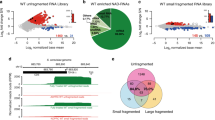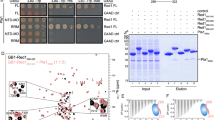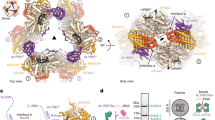Abstract
An emerging theme in messenger RNA metabolism is the coupling of nuclear pre-mRNA processing events, which contributes to mRNA quality control1. Most eukaryotic mRNAs acquire a poly(A) tail during 3′-end processing within the nucleus, and this is coupled to efficient export of mRNAs to the cytoplasm2,3. In the yeast Saccharomyces cerevisiae, a common consequence of defective nuclear export of mRNA is the hyperadenylation of nascent transcripts4,5, which are sequestered at or near their sites of transcription5. This implies that polyadenylation and nuclear export are coupled in a step that involves the release of mRNA from transcription site foci. Here we demonstrate that transcripts which fail to acquire a poly(A) tail are also retained at or near transcription sites. Surprisingly, this retention mechanism requires the protein Rrp6p and the nuclear exosome, a large complex of exonucleolytic enzymes6,7. In exosome mutants, hypo- as well as hyperadenylated mRNAs are released and translated. These observations suggest that the exosome contributes to a checkpoint that monitors proper 3′-end formation of mRNA.
This is a preview of subscription content, access via your institution
Access options
Subscribe to this journal
Receive 51 print issues and online access
$199.00 per year
only $3.90 per issue
Buy this article
- Purchase on Springer Link
- Instant access to full article PDF
Prices may be subject to local taxes which are calculated during checkout



Similar content being viewed by others
References
Maquat, L. E. & Carmichael, G. G. Quality control of mRNA function. Cell 104, 173–176 (2001).
Eckner, R., Ellmeier, W. & Birnstiel, M. L. Mature mRNA 3′ end formation stimulates RNA export from the nucleus. EMBO J. 10, 3513–3522 (1991).
Huang, Y. & Carmichael, G. C. Role of polyadenylation in nucleocytoplasmic transport of mRNA. Mol. Cell. Biol. 16, 1534–1542 (1996).
Hilleren, P. & Parker, R. Defects in mRNA export factors Rat7p, Gle1p, Mex67p and Rat8p cause hyperadenylation during 3′ end formation of nascent transcripts. RNA 7, 753–764 (2001).
Jensen, T. H., Patricio, K., McCarthy, T. & Rosbash, M. A block to mRNA nuclear export in Saccharomyces cerevisiae leads to hyperadenylation of transcripts that accumulate at the site of transcription. Mol. Cell 7, 887–898 (2001).
Briggs, M. W., Burkard, K. T. & Butler, J. S. Rrp6p, the yeast homologue of the human PM-Scl 100-kDa autoantigen, is essential for efficient 5.8 S rRNA 3′ end formation. J. Biol. Chem. 273, 13255–13263 (1998).
Mitchell, P., Petfalski, E., Shevchenko, A., Mann, M. & Tollervey, D. The exosome: A conserved eukaryotic RNA processing complex containing multiple 3′→5′ exoribonucleases. Cell 91, 457–466 (1997).
Patel, D. & Butler, J. S. Conditional defect in mRNA 3′ end processing caused by a mutation in the gene for poly(A) polymerase. Mol. Cell. Biol. 12, 3297–3304 (1992).
Burkard, K. T. & Butler, J. S. A nuclear 3′-5′ exonuclease involved in mRNA degradation interacts with poly(A) polymerase and the hnRNA protein Npl3p. Mol. Cell. Biol. 20, 604–616 (2000).
Decker, C. J. & Parker, R. A turnover pathway for both stable and unstable mRNAs in yeast: Evidence for a requirement for deadenylation. Genes Dev. 7, 1632–1643 (1993).
Allmang, C. et al. Functions of the exosome in rRNA, snoRNA and snRNA synthesis. EMBO J. 18, 5399–5410 (1999).
van Hoof, A., Lennertz, P. & Parker, R. Yeast exosome mutants accumulate 3′-extended polyadenylated forms of U4 small nuclear RNA and small nucleolar RNAs. Mol. Cell. Biol. 20, 441–452 (2000).
Bousquet-Antonelli, C., Presutti, C. & Tollervey, D. Identification of a regulated pathway for nuclear pre-mRNA turnover. Cell 102, 765–775 (2000).
Gorsch, L. C., Dockendorff, T. C. & Cole, C. N. A conditional allele of the novel repeat-containing yeast nucleoporin RAT7/NUP159 causes both rapid cessation of mRNA export and reversible clustering of nuclear pore complexes. J. Cell Biol. 129, 939–955 (1995).
Lee, M. S., Henry, M. & Silver, P. A. A protein that shuttles between the nucleus and the cytoplasm is an important mediator of RNA export. Genes Dev. 10, 1233–1246 (1996).
Vainberg, I. E., Dower, K. & Rosbash, M. Nuclear export of heat shock and non-heat-shock mRNA occurs via similar pathways. Mol. Cell. Biol. 20, 3996–4005 (2000).
Mandart, E. & Parker, R. Effects of mutations in the Saccharomyces cerevisiae RNA14, RNA15, and PAP1 genes on polyadenylation in vivo. Mol. Cell. Biol. 15, 6979–6986 (1995).
Amrani, N., Dufour, M. E., Bonneaud, N. & Lacroute, F. Mutations in STS1 suppress the defect in 3′ mRNA processing caused by the rna15-2 mutation in Saccharomyces cerevisiae. Mol. Gen. Genet. 252, 552–562 (1996).
Acknowledgements
We thank I. Mattaj for critically reading the manuscript. This work was supported by the Howard Hughes Medical Institute.
Author information
Authors and Affiliations
Corresponding author
Supplementary information
Rights and permissions
About this article
Cite this article
Hilleren, P., McCarthy, T., Rosbash, M. et al. Quality control of mRNA 3′-end processing is linked to the nuclear exosome. Nature 413, 538–542 (2001). https://doi.org/10.1038/35097110
Received:
Accepted:
Issue Date:
DOI: https://doi.org/10.1038/35097110
This article is cited by
-
Mechanisms and consequences of mRNA destabilization during viral infections
Virology Journal (2024)
-
Hypoxia-driven deSUMOylation of EXOSC10 promotes adaptive changes in the transcriptome profile
Cellular and Molecular Life Sciences (2024)
-
Promoter-dependent nuclear RNA degradation ensures cell cycle-specific gene expression
Communications Biology (2019)
-
SAGA DUBm-mediated surveillance regulates prompt export of stress-inducible transcripts for proteostasis
Nature Communications (2019)
-
The regulation and functions of the nuclear RNA exosome complex
Nature Reviews Molecular Cell Biology (2016)
Comments
By submitting a comment you agree to abide by our Terms and Community Guidelines. If you find something abusive or that does not comply with our terms or guidelines please flag it as inappropriate.



